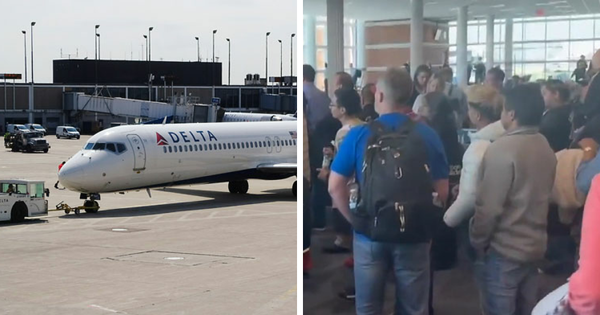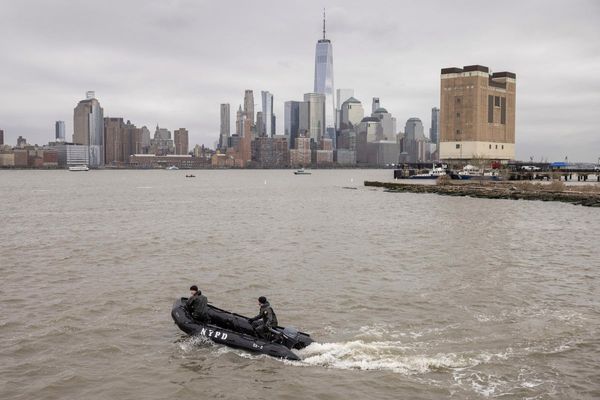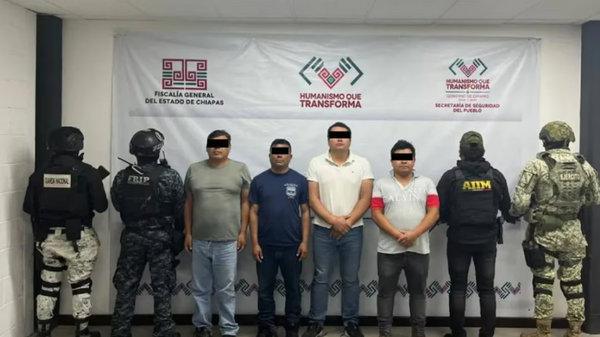
Huddled on Afghanistan’s chaotic border with Pakistan, his young son shivering in the cold, Mohammed Ibrahim stared at the unmoving metal gates – willing them to open, even just for a moment.
“We spent the night there in the middle of the street with little Daniel and it was [the most] difficult night of my life,” he says.
“Without food, water and blankets we stood until morning in the middle of thousands of people … but they did not allow anyone in and we come back again to Kabul.”
Back to the Taliban.
Stranded
Since the fall of Kabul and the descent of Afghanistan back into Taliban rule, there have been many dark days. The passage of nearly half a decade has dimmed neither the fear nor the threat.
Mohammed Ibrahim, now in hiding with his wife, Amina, and two children, Daniel and Helene, is a target of the Taliban because he worked on behalf of the Australian government.
Between 2011 and 2015 in republican Afghanistan, he was employed by the international NGO Save the Children on a program known as Children of Uruzgan. It was funded by Australia’s Department of Foreign Affairs and Trade.
The program built and ran schools for children in one of Afghanistan’s poorest provinces, aiming to establish 50 kindergartens across a part of the country where six in 10 children never set foot inside a classroom. It taught girls to read and vaccinated children who never visited a hospital. The program trained dozens of doctors in neonatal care in the country with the highest infant mortality rate in the world.
In the middle of it all was Ibrahim, quietly travelling from village to village, translating for Australian aid workers as they spoke with village elders, delivering vaccines to doctors, distributing cash to rural women.
Ibrahim was proud of his work and the difference it was making in the forgotten corners of Afghanistan: “Working on those projects was an honour for me to serve my country and also help the Australian government.
“But later my connection with the Australian government and work experience with Save the Children became a danger for me and my family’s life. Because the Taliban think we are infidels and need to be killed because we worked and helped foreigners.”
That Ibrahim’s work on behalf of Australia has made him a target has been recognised by the Australian government. He has been granted locally engaged employee (Lee) certification – a formal recognition for those who worked with and for Australia “and are at risk of harm as a result of their work”.
But Ibrahim is still stranded.
‘Infidels’
Kabul fell with a terrifying swiftness on the morning of 15 August 2021. Two decades of Afghanistan’s flawed and fragile republican experiment collapsed with barely a whimper after a calamitous withdrawal deal Donald Trump signed with the Taliban.
International hopes for a reformed Taliban, that their desire for international legitimacy would restrain the most grotesque of their tendencies – their silencing of women, their brutality towards minorities – were short-lived. The Taliban were unrepentant, unreformed.
Those who had served the former administration and the western infidels who had backed it, or those who were members of ethnic minorities such as the Hazara, were cowed back into the shadows.
Ibrahim – both – was forced to flee.
Outside his work Ibrahim had used his burgeoning multimedia skills to film short videos of life in the mountainous villages of his home province, posting them online as a celebration of Hazara music, art and culture. But the footage shows music and poetry performances, women playing sport and with their faces uncovered: further antagonising the fundamentalist Taliban.
In the long years since, he and his family have led a precarious, peripatetic existence, skipping from his home province to remote mountain villages to the capital, Kabul, and back and forth over the country’s dangerous borderlands.
“Taliban visited my house … and asked my neighbours, ‘Where are your infidel neighbours? We have to find them, we must arrest them because they are infidels.’ And my neighbours told [them] that I ran away and they don’t know where I escaped to.”
Ibrahim hoped Kabul’s size might offer protection. But even there were Taliban who knew his history.
“We had to change our location every day and week so they could not find us,” he says.
Patrols prowled the streets, stopped people and demanded documents. Gunmen followed others to their homes. Dozens crowded into tiny, dark apartments, too frightened to go out.
“Everywhere was Taliban … I will never forget those difficult days we spent hungry and thirsty with a lot of fear there because Taliban were searching for us and we were not able to even go to a shop to purchase food.”
Ibrahim and his family set out on foot for Torkham, the mountainous border crossing into Pakistan. But after their cold and difficult night at the closed frontier they were forced to turn back.
In Kabul, each day brought news of more arrests of those who had worked for international agencies or served foreign governments. Sometimes they were seized from street corners. More commonly people – sometimes whole families – simply disappeared.
The net grew tighter. Ibrahim feared not only for his family’s safety but also for anyone who had sheltered them, assisted them, even fed them.
“Again, I tried to go to Pakistan and this time I spent two days and one night on the border due to rush of the people. We slept the night on the streets under the rain and cold weather.
“Daniel, my son, was three years old at that time. He was very sick and had a very high fever. I was not sure that he could get better and I was afraid for him. I was very worried because … four or five children died in front of my eyes on the border.”
This time they made it across. Pakistan was a sanctuary of sorts. The Taliban’s reach was weaker, though not extinguished. But among thousands of Afghan immigrants, Ibrahim and his family were at the mercy of unscrupulous landlords who exploited their lack of connections and temporary documents. When their visas expired, they were expelled back into Afghanistan.
Since then, the unhappy dance has continued. Sometimes every few days, Ibrahim and his family will pick up and leave, careful not to compromise anybody with information about where they might be headed.
Occasionally, too rarely, they get a few weeks of quiet, of relative stability. But always with the knowledge it could end without warning – with a flash of recognition on a street corner, a suspicion insufficiently appeased.
Guardian Australia is not revealing where – not even which country – the family are now sheltering.
‘Delays, double handling’
Trying to get to Australia is a two-step process. The first, obtaining Lee certification, is a reflection, the government says, of “Australia’s view of its moral obligation to current and former employees who have provided valuable support to Australia’s efforts in Afghanistan”.
Alone, it counts for little – it’s not much more than another compromising document should it fall into Taliban hands.
The second step is applying for and securing a visa to Australia. (A Lee program review found the two-step process “causes delays, double handling and confusion, and imposes an administrative burden on applicants”. It heard numerous Lee candidates had been “left behind” in danger in Afghanistan.)
Ibrahim’s Lee certification means the family’s application for humanitarian visas will be prioritised – a recognition that it is their connection to Australia that has brought them into danger.
But there are barriers still. Ibrahim’s application for a humanitarian visa has sat with the Department of Home Affairs since 2022.
Stranded in Afghanistan, Ibrahim has found himself caught in a bizarre catch-22. The Australian government told him it could not progress his visa application from within Afghanistan but, at the same time, advised him not to leave the country.
A letter from Dfat told him: “Due to the closure of panel doctors in Afghanistan, we are currently unable to invite applicants to undertake medicals if located in Afghanistan.
“The department is unable to assist clients to travel outside of Afghanistan, and do not advise travel due to safety concerns.”
‘Serious mess’
Ibrahim has a web of support that stretches around the world. He has letters of recommendation from former colleagues as far afield as Singapore and the US.
From Australia, he has offers of housing and community support, even employment.
Government figures provided to Guardian Australia show that to the end of January, 2,427 Afghans have been Lee certified: 674 by Dfat, 1,741 by the defence department and 12 by Australian federal police.
Barely a third of them have reached Australia – 817 have travelled to Australia on class XB visas (with 2,368 immediate family members), while 82 have been granted visas (with 321 family members) and 116 applications for humanitarian visas are before the Department of Home Affairs.
“The former Liberal government failed to adequately plan for the evacuation of Afghan LEE and former ministers, including Peter Dutton, oversaw a program plagued by inconsistent and irregular decision making and poor communication with applicants,” said a spokesperson for the foreign affairs minister, Penny Wong.
Since Wong took office in 2022, more than 500 applicants have been certified under Dfat’s program –including Ibrahim – more than all previous foreign ministers combined.
“The Albanese government is focused on cleaning up the serious mess left by the Morrison government and we remain committed to doing what we can to assist those who helped Australia’s mission in Afghanistan.”
Ibrahim is planning the next move with his family. The plan is uncertain, contingent on what is possible, on the squeeze-and-release of the Taliban’s capricious rule.
He is keeping his children warm through a bitter winter with the hope that spring may bring better news.
“I would like to come to Australia,” he says quietly. “Because I and my family will be safe from being arrested and killed by the Taliban.”







